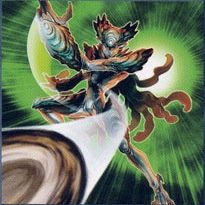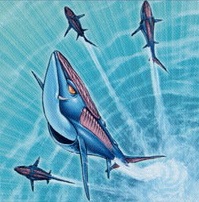The coelacanth and I have a few things in common. Both of us disappeared for an extended period of time only to reappear to the surprise of others. On the other hand, the coelacanth is a fish so old and so far back on the evolutionary scale that when it was discovered to be alive, scientists actually nicknamed it a "living fossil" in celebration of its survival. Whereas when I come back, the response is something more like, "Forget something?" or alternatively, "Where the heck have you been?"
Okay, so maybe I was stretching—the coelacanth and I don’t really share much common ground. For one, I am bipedal, and for two, it’s a fish. No, what I refer to today is the Coelacanth: Superancient Deepsea King Coelacanth. That card and I have a lot more in common with each other than a prehistoric fish that fits equally well on a dinner plate as it does in a museum. See, Deepsea King and I both really like this card:

Oyster Meister
Level 3
1600 / 200
When this card is sent from the field to the Graveyard, except when destroyed by battle, Special Summon 1 "Oyster Token" (Fish-Type/WATER/Level 1/ATK 0/DEF 0).
By the time I’m finished writing, you will have something in common with me and the aforementioned aquatic royalty. You too will really like Oyster Meister.
The effect itself is simple enough—put it on the field, take it off, put something else on the field instead. The stats are nice, allowing it to slip past a few stall cards and run over Gladiator Beast Bestiari with ease. Its attribute and type are useful for reasons I’ll soon get into. I’m going to allow a tangent here, because it is relevant to discussing Oyster Meister and its place in Fish decks. I would recommend you review Coelacanth’s effect text because I’ll mention it a lot too.
Currently and always, card advantage has been a significant (though not necessarily correct) focus of most players because it is concrete and tangible. So tangible you can hold it in your hand (har har), and it’s very tricky to design support for a theme that doesn’t somehow revolve around card presence as a result. The flip side to this is that something like Scapegoat may supply an advantage of card presence in that you consume one card to get four pseudo-cards, but they have little purpose once they hit the field. Having lots of cards is nice, but without some way to leverage it into something contributing toward a win it is worthless, and one way to exploit an extra card is to use something that trades that card for something else. Do it consistently and you have what I call an engine. For instance, you could turn a field of 0 ATK / 0 DEF monsters into, say, 2000 damage or Thousand-Eyes Restrict, with Cannon Soldier or Metamorphosis.
Engines that trade one thing for another are seen in most successful decks. Metamorphosis turns two cards into one card of your choice. Cannon Soldier turns cards into damage. Crass Clown, Des Lacooda, Solemn Wishes and Stealth Bird make use of time and turn your longevity into life points, hand presence, or field presence respectively. The ability to trade one thing for another is a crucial part of the game, and cards that create an engine to do this tend to be very solid parts of a deck. Thinking about things like this sometimes helps in deck construction.
What Oyster Meister does is give you a starting point to exploit, with the aid of your deck’s other cards. In that way this card is possibly the most fortuitous thing that has ever happened to the Fish theme. Oyster Meister (difficult to say five times fast) does a lot of things, but for brevity they can be narrowed down to two core concepts: creating an engine to generate field presence, and enabling the cards that benefit from it.
Oyster Meister is great because it supplies you with two monsters in return for your playing just one, and as an added bonus its effect is mandatory. That means that you can’t miss the timing on Oyster Meister’s effect, so you can tribute it for a tribute summon or an activation cost. It reminds me a lot of a card I mentioned earlier in this article, Superancient Deepsea King Coelacanth. Oyster Meister gives you the option to trade it for another monster on the field. Coelacanth gives you the option to turn a card in your hand into four more. In some ways Oyster Meister and Coelacanth are incomparable, like oranges and apples, but at the same time it’s worth remembering that both apples and oranges are fruits. The end goal each monster achieves is the thing that links these two cards together. Both can put monsters on the field, but if you can’t do anything with those monsters (both are useless for effects and attacks) you’re probably just going to end up losing them. Coelacanth is great: his effect allows you to generate field presence repeatedly at marginal cost, and even though the monsters Coelacanth summons can’t do anything, he is always up for eating them to save his own hide should he be targeted by something. Both of these monsters let you keep your field full, and let you fulfill the cost requirements of other cards . . . which brings me to my next point.
Oyster Meister’s second trait, which is the ability to fuel your other cards, makes it a great windfall for Fish because it lets you make a very cohesive deck with lots of card interaction. Put simply, combos! I’ll list a few of the more prominent and exciting ones here.
Since it has the Water attribute, Oyster Meister can be used to pay the cost of Spiritual Water Art - Aoi and Cranium Fish. And since it’s a Fish, Superancient Deepsea King Coelacanth can not only summon it to the field, but will gladly eat the Oyster to use its built-in protection effect and net you a Fish token in the process. You claim Oyster Meister’s effect despite Coelacanth’s negation drawback, because Oyster Meister’s ability will activate in the graveyard where Coelacanth won’t negate it. Golden Flying Fish eats up to two of your opponent’s cards when paired with Oyster Meister, and Fish Depth Charge might have something to do with it being a little good, too. (Perhaps "a little too good" is more appropriate?)

Fish Depth Charge
Tribute 1 Fish-type monster. Destroy a card on the field, and draw a card.
Fish Depth Charge is a lot like Spiritual Water Art—it’s chainable, it’s powerful, and it’s quite easy for you to meet its activation condition. It obviously goes well with Oyster Meister, and both it and the Water Art are virtually free if you have Coelacanth out. But this card is honestly just exciting to me. Fish Depth Charge + Oyster Meister is nearly a perfect first turn play, allowing you to lure out an opponent’s monster or spell or trap destruction, trade your Oyster for the opponent’s card, draw another card and still leave a token on the field to tribute for a summon next turn (or perhaps to feed another Fish Depth Charge!). The very fact that Fish can now make this play is exciting.
Now, with Golden Flying Fish, Spiritual Water Art - Aoi and the recent addition of Fish Depth Charge, you can easily leverage the raw card presence supplied by Coelacanth and Oyster (is this a deck or a seafood menu?) into field presence, or just take a bite out of your helpless opponent with Coelacanth. Long story short, you could clear an entire field with the Flying Fish, cripple the opponent’s hand with Aoi, and supply chainable destruction with Depth Charge.
It’s very hard to talk about Oyster Meister by itself, because it’s a team player. By itself it’s just a 1600 ATK monster with a solid defensive effect. But with Coelacanth summoning three Oyster Meisters, that’s effectively six monsters on your field. Six monsters you can use with Golden Flying Fish or Coelacanth itself, or with Spiritual Water Art - Aoi or Creature Swap or Enemy Controller or Fish Depth Charge. This card is good by itself, but it’s even better when you consider how many cards it works with. It’s so good, I might even go so far as to call it a staple for Fish decks.
And Fish Depth Charge is just plain amazing. One of the things I always liked about chainable cards like this or Magical Dimension (chainable cards with costs), is that if either the cost or the card itself comes into jeopardy you can use it to make the threatening card look silly. If Smashing Ground or Dust Tornado gets activated, you chain Fish Depth Charge and your opponent just wasted his or her destruction effect. This seems like common sense, right? So what’s the big deal?
Well, the big deal is the fact that now, Fish can play on an even field with other themes thanks to all these fancy tricks. It’s the fact that something that seems simple to players who understand intermediate concepts, can now be done for the first time ever in an under-supported theme. If you had told me two years ago that Fish would get the same level of support Gravekeepers or Spellcasters have, I’d have looked at you as though you just tried to trade me the city of London for a bottle of soda. If we can say that Fish have support like Fish Depth Charge, and combos like Oyster Meister and, well, anything at all . . . and beatsticks like Coelacanth, there isn’t really much to say past that. That is more exciting than anything else for a lot of players who want to prove that they can succeed with an interesting and unique deck.
Hopefully my attempt to warm your hearts to these cards didn’t flounder. If you liked it, or any other cards you have seen these past two weeks here on Metagame.com, make your way to The Duelist Genesis Sneak Previews in your area and see what fish you catch (or what cards you get, whatever).
Until next time, duelists!